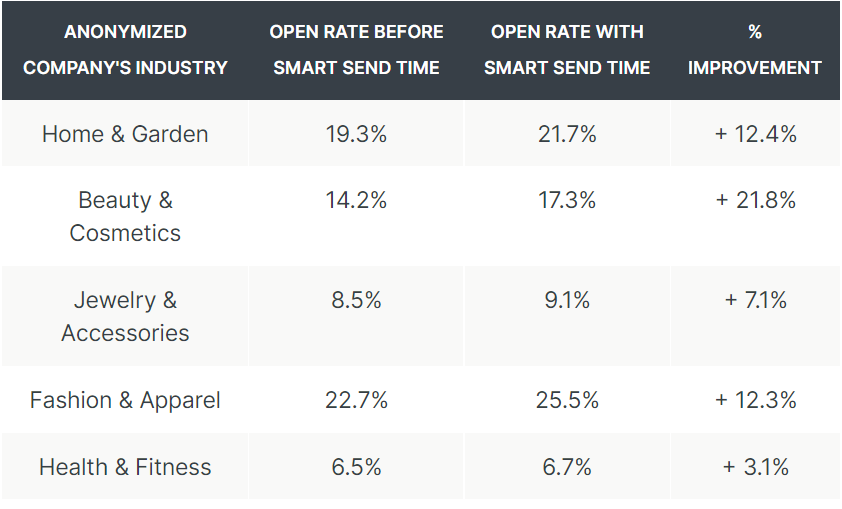Turns out Intelligent Time is not when you drink 5 Red bulls, eat a handful of Skittles, and go into your High School Geography exam. That's called The Big Brain Event and it's a completely different thing.

Basically, intelligent time email sending uses machine learning to allow companies to send personalised emails. Easy as.
In fact, send time optimisation can increase the open rate of your email campaign by up to 25%.
But this is personalisation, but not as you know it: it's based on your customers schedule, time zone, and lifestyle. So, it's about figuring out the time when your prospect is most likely to engage.
Intelligent Time email sending, or send time optimisation, or any of the 100 terms used for it, automates the slow, laborious, difficult process of figuring out this ideal time.
So, how does it work?
Well, to begin with, send time optimisation starts collecting data based on previous campaign data, and then it creates a profile for each recipient.
Then it can use this data to determine the most likely time the reader will open the emails.
This process utilises AI and machine learning to detect when these customers actually check their inbox. The message is then sent to each individual at a time which fits them best. So, it's all about getting your email to the top of the inbox just at the right time.
The algorithm might even be set to send the email 30 minutes before the optimal time in order to make sure it's sitting pretty right at the top of the inbox.

Using these personal profiles, and analysing response behaviour, you can create a detailed story of your customer. So, as time goes on, and the longer the customer relationship, the more accurate the send time becomes. And if their behaviour changes, the profile will too.
Opens themselves don't tend to provide sufficient information on whether a recipient is interacting properly. So, the algorithm also analyses click behaviour and message opens.
A majority of people click through their inbox to get that little red number down to zero. This means that these individuals are less likely to read the campaigns in depth, or follow links. So, by taking the click behaviour into account, the AI solution can determine when they are focused and responsive, and not just getting their inbox number down.
Testing, testing, 1,2,3.
Intelligent Time Email Sending tries to get to the bottom of the optimal sending time using a combination of previous campaigns, active sending, and constantly learning from both.
The campaign will be sent at regular intervals over a 24-hour time period in order to check open rates across the day. Though there's a bit of a downside, as some emails will be sent at suboptimal times with lower open rates, but this will mean the company knows it's optimal send time for future emails. I mean, it might turn out your customers are huge night owls.
Each time this is sent, the model will test the result and ensure the send time is optimal, and still optimal in future tests.
When the information on the open and click rates has been collected, the system will automatically analyse the data, and learn from it.
In what other ways can intelligent email sending be used?
- Geographic difference. The intelligent email sending can be super helpful if you've got customers in multiple time zones, so you can make sure you personalise by considering geographic factors too.
- Email timing calibration. Sending too many emails might make your subscribers jump ship. But too few, they might forget about you, or choose a competitor. The algorithm takes the guesswork out, and determines the right times to send out emails, as well as the frequency
- New segments. Machine learning can develop the segments you have beyond the usual categories, and can move to specific behavioural signals. These subtle patterns can be turned into new and distinct marketing segments that can be treated with customised campaigns.
This is all not too dissimilar to what marketers already do, but just on a more effective, time-saving, industrial scale.
“You’ll play around with send time, and when should I send it,” said Paul Roetzer, CEO and founder of the Marketing Artificial Intelligence Institute
“Maybe you do that by what time zone they're in. You're probably going to play around with subject lines. You may play around with the links within it. You're going to kind of just keep testing things looking for what's going to get more of the outcome I desire from my newsletter.”
But the machine can process thousands of these behaviours and data points, and can apply these to future campaigns.
All this doesn't mean you can get rid of your copywriters, though. Please. You can still add the human element to every piece of copy. So, you can do all the fun bits, and let the machines do all the boring stuff.
With your marketing, you can't rely on a 'one-size-fits-all' approach any more. Customers expect high levels of personalisation at all times.
Why email matters
Recently, marketers have been putting a bunch of emphasis on webinars, social media, video marketing, or anything shiny they come across.
But anything new and exciting shouldn't distract you completely from the fundamental and effective methods of marketing.
Email generates $42 for every $1 spent which is an astounding 4,2000% ROI. So it may be old, but it's not old hat. Plus, more than three-quarters of marketers report that emails are becoming more effective, or at least holding steady.

Email marketing is alive and kicking. In fact, according to Litmus, 2020 was a year of email. But don't people hate getting emails? I hear you ask. No, people hate getting spam emails. If you keep your emails helpful, personalised, informative, and relevant, then you can build trust with your contacts. And this will lead to engagement. Which will lead to sales!
Email marketing has been, and will remain, super affordable. In terms of how it can reach customers, it costs mere pennies to get your message out there. As many small businesses are working on a pretty strict budget, email gives them the chance to keep up with bigger, and better funded, competitors. Email marketing involves very little upfront cost, and is relatively inexpensive to maintain over time. So don't anticipate any hidden costs.
…but does send time matter?
Oh come on now, what a question. Like we've just spent all this time on this article, and we're going to turn round and say no.
Right, you mean why does it matter? Well, let's get into it.
You wouldn't send a Christmas email in May, or a Birthday email before someone's birthday. Timing works on a micro as well as a macro level, too.
We all know how much difference personalisation can make, in any way. So, in order to maximise open rates and click-through, you need to consider your send time.
Customers can't act on the content in your email if they don't open it, or have the time to read the copy. Send time optimises the amount of eyes on the content of your email at any point.
A test conducted by Klaviyo proved this. Conducting a private beta test with 15 customers, they found that the ten brands saw an increase in email open rates of 10% on average. 10. whole. percent. Basically, the optimal send time performed four times better than any other optimisation technique.

What are the benefits of well-constructed, intelligent time sending?
Well, if you're going above and beyond by using a machine, you should see some good results. For example, you could:
- Increase the open rate for your emails by up to 25%
- Decrease the likelihood of being ignored
- Advertising will be seen as less bothersome or intrusive
- Keep up with your customers. The intelligent time email sending can change with your customers behaviour and lifestyle shifts.
- Save marketers time and effort with both testing and categorisation
Has this answered your burning questions? No? Well then, check out all the biggest email timing FAQs right 👉👉👉here!
